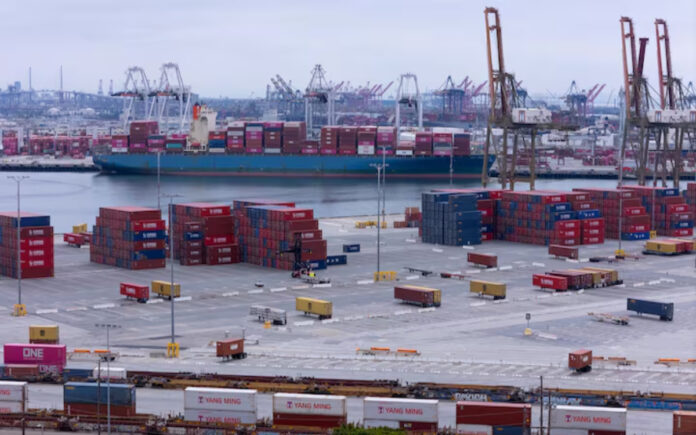Los Angeles: Major container shipping companies have suspended at least six weekly services between China and the United States, as escalating tariffs imposed by President Donald Trump take a heavy toll on global trade, according to maritime analysts.
These suspended services collectively account for the weekly capacity to transport 25,682 forty-foot containers—equivalent to over 1.3 million containers annually—carrying essential goods such as toys, footwear, car parts, and raw materials vital to U.S. manufacturing, based on customer advisory data.
The decision to cut services, coupled with increasing cancellations of individual voyages, reflects how shipping giants are scrambling to shield operations from the volatility caused by Washington’s trade policies.
“This is not the precursor, it is the proof of a drop in economic activity,” said Simon Sundboell, CEO of Danish maritime data provider eeSea, commenting on the visible contraction in container vessel deployment.
The suspended routes include weekly services operated by major carriers such as MSC, Zim, and the Ocean Alliance—which comprises Cosco, Evergreen, CMA CGM, and OOCL—Sundboell added. The reductions impact U.S. ports across the West Coast, East Coast, and Gulf Coast.
The shipping lines responsible for these cuts either declined to comment or did not respond immediately to requests. Meanwhile, Maersk and Hapag-Lloyd, members of the Gemini Alliance, have not suspended any services despite facing booking declines from China to the U.S. in April. Instead, they have deployed smaller vessels to manage capacity.
In the face of these disruptions, U.S. and Chinese officials are meeting this weekend in Switzerland, aiming to break a months-long deadlock over trade issues.
Surge in Blank Sailings Reflects Industry Pressure
Shipping firms are resorting to blank sailings—canceled voyages without alternative scheduling—to stabilize revenue and avoid deploying excess capacity. This strategy, widely used during the COVID-19 crisis, has helped carriers maintain high profit margins by balancing supply with declining demand.
Blank sailings on the key Transpacific corridor from Asia to North America spiked sharply, rising from 9% in the week ending March 30 to 24% by the week ending May 4, according to data from maritime consultancy Drewry.
Drewry’s figures show that capacity on Asia-to-West Coast North America routes fell by 20% in April and 12% in May, while East Coast routes experienced even steeper cuts—22% in April and 18% so far in May.
Also Read | Delayed Iran-US Nuclear Negotiations to Resume Sunday in Muscat
In April, MSC, the world’s largest container operator, canceled 30% of its scheduled Transpacific voyages—more than any other carrier, said Daniela Ghimp, project manager for ocean freight rate benchmarking at Drewry.
In May, the Premier Alliance—consisting of Ocean Network Express (ONE), Hyundai Merchant Marine (HMM), and Yang Ming Marine Transportation—led with a 20% blank sailing rate. ONE declined to comment, while HMM and Yang Ming have yet to respond.
The trade slowdown has also prompted major U.S. retailers like Amazon and Walmart, which together account for nearly half of global containerized imports, to pause or cancel new factory orders. This follows Trump’s recent 145% tariff hike on Chinese goods, which drastically increased import costs and created further uncertainty for buyers.
Also Read | FTC Supports DOJ’s Antitrust Measures Against Google, Endorses Privacy Safeguards
Looking ahead, experts warn that the full impact of the tariffs may not materialize until July. John McCown, senior fellow at the Center for Maritime Strategy, said U.S. container import volumes could drop by 25% or more year-on-year by then.
“Something’s gotta give, and I believe either considerably more capacity will have to be culled, or spot rates will start to crash,” warned Alan Murphy, CEO of Sea-Intelligence.



